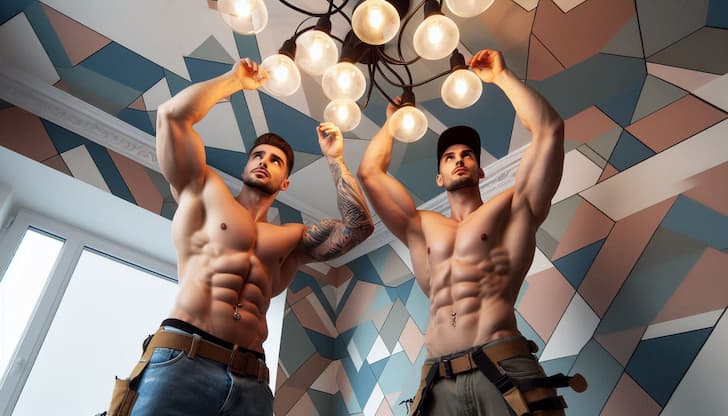Cubism is an art movement that first appeared in the early 20th century. When I think about it, what stands out most is how cubism approaches shapes and forms. Instead of showing things as they are seen in real life, cubist artists break down their subjects into geometric shapes and bold lines. This unique approach creates a modern, abstract feel that still attracts art lovers and designers today.
If you’re interested in cubism home decor, you’re not alone. I find that more people want to bring artistic statements into their living spaces, making rooms more vibrant and personal. Cubism home decor is an easy way to create a bold and meaningful look without needing a full room makeover. These ideas work in both small apartments and big houses, offering styles that fit different tastes and budgets.
In this article, I’m sharing 10 cubism home decor ideas. Each one offers practical ways to add geometric flair, creative color, and the essence of abstract art to your home. Whether you want subtle touches or an eye-catching centerpiece, I’ll show you how to make cubism work in your living space.
1. Cubist Wall Art for Instant Impact
Cubist wall art is probably the easiest way to give a room a modern, artistic look. I like to hang large prints or canvases that feature cubist paintings or geometric abstract designs. These pieces usually combine rectangles, triangles, and odd angles with bold or muted colors.
Where to Start:
- Hang one large painting above your sofa or bed for a bold touch.
- Create a gallery wall using several smaller cubist prints in similar color palettes.
- Pick frames in simple black, white, or metallic finishes to keep attention on the artwork.
Art prints, posters, and even DIY canvas projects all count. I find sites like Saatchi Art or Etsy have a range of options for any budget. Exploring local galleries or even making your own cubist-inspired canvas can also provide a personalized touch to your space while supporting small businesses or showcasing your creativity.
2. Geometric Throw Pillows
If I want to update my decor without a huge commitment, I swap out throw pillows. Pillows are an easy way to add cubist patterns and bright colors to any room. Look for covers with geometric shapes, blocks of color, and sharp lines or angles.
How I Style Them:
- Mix square, rectangular, and round pillows for variety.
- Use a minimum of three pillows with different, but coordinating, cubist designs.
- Keep the rest of the couch or bedding neutral so the pillows really stand out.
Choosing throw pillows can even become a fun DIY project. With fabric paint or iron-on transfers, you can create custom designs that add personality to your living space. Additionally, swapping out pillow covers seasonally is a budget-friendly and creative way to keep your room feeling fresh all year round.
3. Rugs with Abstract, Cubist Patterns
A patterned rug adds warmth while tying the whole room together. When I choose a rug with a cubist pattern, such as bold geometric shapes or overlapping angular designs, the effect is immediate and stylish.
Area rugs work well for living rooms, bedrooms, or entryways. For a big impact, I choose a rug that covers most of the floor space and echoes colors from the rest of the decor. Don’t forget to consider the material—wool, cotton, and synthetic blends each bring their own vibe and practicality. For extra style points, layer rugs by placing a smaller, eye-catching cubist rug on top of a neutral base.
4. Cubism Inspired Lighting Fixtures
Lighting can be more than just practical. I like using table lamps, pendant lights, or even floor lamps that have a cubist edge. Think about fixtures with angular metalwork, layered glass, or bold geometric shades.
Cubist Lighting Ideas:
- A stained-glass pendant with abstract shapes and bold color sections;
- Table lamps with a base or shade made up of stacked cubes or rectangles;
- Wall sconces that cast geometric shadows when lit.
Statement lighting gives any room an artistic touch, especially when combined with other cubist accents. Dimming features or smart bulbs can let you set the mood to match the shifting daylight or your mood—whether you’re ready to unwind or entertain friends. Pick lighting that can be both functional and sculptural, serving as both illumination and decor.
5. Furniture with Geometric Designs
Furniture can often act as art, especially if the form itself draws the eye. I look for coffee tables, bookshelves, or side tables that use angular lines or asymmetrical shapes. Even a simple cubeshaped ottoman adds to the cubism feel.
Selecting the Right Pieces:
- Go for sleek, modern pieces in neutral woods, lacquered blacks, or bright pops of color.
- Mix and match furniture with straight lines and unexpected angles to echo cubist forms.
- Try using twotone finishes or a mix of contrasting materials for more depth.
For a more subtle approach, focus on one or two standout pieces rather than a whole room makeover. Unique shelving units with irregular compartments, modular sofas with defined shapes, or side tables with angled legs can all give a boost to the cubism vibe in a practical way.
6. DIY Cubist Mural or Accent Wall
Creating an accent wall is one of the most creative ways I’ve found to bring cubism into a room. With a little painter’s tape and some sample pots of colorful paint, I can design my own cubistinspired mural.
Simple Steps:
- Tape off geometric shapes (triangles, rectangles, polygons) across your wall.
- Fill in the shapes with different colors, sticking to a color palette that matches your room.
- Allow paint to fully dry between colors to prevent overlaps.
This works best behind a bed, sofa, or dining table where you want to draw attention. If a whole wall feels overwhelming, try making a framed mural on a large canvas or board—you can move it if you ever want to change things up. Temporary wallpaper featuring cubist motifs is another renterfriendly option.
7. Abstract Cubist Vases and Decorative Objects
Small decor pieces like vases, trays, or sculptures create points of interest, even in minimalist rooms. I look for decorative items that mimic cubist art, and these often feature angles, geometric cuts, and bold painted sections.
Examples I Like:
- Stacked block vases with contrasting colors;
- Ceramic sculptures with broken shapes and angular edges;
- Decorative trays or bowls painted with cubist patterns.
Spreading out a few of these objects on shelves, mantels, or coffee tables helps reinforce the cubist style without overdoing it. If you enjoy crafts, many DIY guides are available online to create your own cubist-inspired pottery or home accessories using clay, concrete, or wood. Mixing vintage finds with modern accessories can add character to your arrangements as well.
8. Cubist Mirrors That Play with Shape
I find that mirrors are an underrated way to add both light and cubist energy to the room. Instead of standard round or rectangular mirrors, I look for those with asymmetric frames, segmented mirror panels, or bold angular borders.
Mirrors like these catch the eye and reflect light, making the room feel larger and more dynamic, especially in small apartments or dark corners. For a custom look, consider grouping several smaller mirrors together in a geometric arrangement, almost like a wall sculpture. Mirrored furniture with angled fronts or faceted surfaces can also bring a subtle cubism influence to your space.
9. Tableware and Kitchen Accents with Cubist Flair
Bringing cubist design into the kitchen or dining room is easy when I use tableware with bold patterns, geometric shapes, or abstract color blocking. Plates, mugs, and even placemats with sharp lines and angular sections stand out during meals and gatherings.
Ideas to Try:
- Geometric serving trays or platters;
- Colorblocked mugs, bowls, or coasters;
- Napkins or table runners featuring cubist prints.
You can find these at many home goods stores or make your own with paint and simple ceramics. Even small touches, such as salt and pepper shakers or utensil holders with geometric motifs, can echo the cubism theme and keep the space feeling cohesive. Choose durable but stylish materials—melamine, enamel, or ceramic can all work nicely and withstand daily use.
10. Window Treatments That Stay True to Cubism
Window treatments, like curtains or blinds, are another way I work cubism into my space. I look for fabrics with geometric patterns, color blocking, or even subtle embroidered shapes.
My Tips for Cubist Window Decor:
- Choose curtains with repeating triangle or square patterns.
- Go for color combinations that echo the rest of your room’s palette.
- Mix solid and patterned panels for variety and depth.
Roman shades or even stained glass window decals with cubist designs can also play with light and color in interesting ways. Layering curtains with translucent materials creates depth and softens bright geometric prints, letting you control how much the pattern stands out.

We earn a commission if you click this link and make a purchase at no additional cost to you.
Extra Tips for Bringing Cubism into Any Room
Mixing cubist pieces with what I already own helps keep my space feeling personal and lived in. Here are a few things I pay attention to for a cohesive look:
- Stick with two or three main colors, and use black, white, or gray for balance.
- Don’t be afraid to layer different textures. Cubism works well with wood, metal, glass, and textiles.
- Combine large, eye-catching pieces with smaller accents spread throughout the room.
- If you want cubism to be the main theme, keep other decor elements simple so the geometric art takes center stage.
It’s also helpful to rearrange your decor from time to time. Moving pieces around can reveal new ways to appreciate their shapes and colors. Remember, there’s no single rule—cubism itself is about breaking away from the ordinary and experimenting with structure and perspective, so it’s the perfect excuse to set your own style guidelines.
Bringing Cubism Home
Blending cubism with everyday decor brings abstract art right where I spend the most time. The geometric shapes, creative color palettes, and playful lines offer a modern look that never goes out of style. Whether it’s through wall art, textiles, or small decorative accents, these ideas can help anyone enjoy the best of cubist design in their own home.
I enjoy experimenting with different cubist touches and seeing how they can transform a room. There’s no rulebook. It’s all about finding what feels right and what sparks excitement for you. If you want your space to reflect both style and creativity, cubism home decor is a great place to start. What cubist idea do you feel like trying first?




